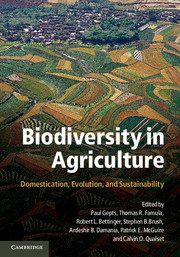13 results
Index
-
- Book:
- Biodiversity in Agriculture
- Published online:
- 05 June 2012
- Print publication:
- 23 February 2012, pp 562-606
-
- Chapter
- Export citation
Figures
-
- Book:
- Biodiversity in Agriculture
- Published online:
- 05 June 2012
- Print publication:
- 23 February 2012, pp x-xiv
-
- Chapter
- Export citation
Frontmatter
-
- Book:
- Biodiversity in Agriculture
- Published online:
- 05 June 2012
- Print publication:
- 23 February 2012, pp i-iv
-
- Chapter
- Export citation
Contents
-
- Book:
- Biodiversity in Agriculture
- Published online:
- 05 June 2012
- Print publication:
- 23 February 2012, pp v-vii
-
- Chapter
- Export citation
Section IV - Traditional Management of Biodiversity
-
- Book:
- Biodiversity in Agriculture
- Published online:
- 05 June 2012
- Print publication:
- 23 February 2012, pp 375-376
-
- Chapter
- Export citation
Section III - Issues in Plant Domestication
-
- Book:
- Biodiversity in Agriculture
- Published online:
- 05 June 2012
- Print publication:
- 23 February 2012, pp 309-310
-
- Chapter
- Export citation
Section II - Domestication of Animals and Impacts on Humans
-
- Book:
- Biodiversity in Agriculture
- Published online:
- 05 June 2012
- Print publication:
- 23 February 2012, pp 225-226
-
- Chapter
- Export citation
Section V - Uses of Biodiversity and New and Future Domestications
-
- Book:
- Biodiversity in Agriculture
- Published online:
- 05 June 2012
- Print publication:
- 23 February 2012, pp 475-478
-
- Chapter
- Export citation
Section I - Early Steps in Agricultural Domestication
-
- Book:
- Biodiversity in Agriculture
- Published online:
- 05 June 2012
- Print publication:
- 23 February 2012, pp 19-20
-
- Chapter
- Export citation

Biodiversity in Agriculture
- Domestication, Evolution, and Sustainability
-
- Published online:
- 05 June 2012
- Print publication:
- 23 February 2012
Contributors
-
- Book:
- Biodiversity in Agriculture
- Published online:
- 05 June 2012
- Print publication:
- 23 February 2012, pp xvii-xxii
-
- Chapter
- Export citation
Tables
-
- Book:
- Biodiversity in Agriculture
- Published online:
- 05 June 2012
- Print publication:
- 23 February 2012, pp viii-ix
-
- Chapter
- Export citation
Chapter 5 - The Anti-Commons Threat to Farmers' Rights: The Case of Crop Germplasm
-
-
- Book:
- The Museum of Bioprospecting, Intellectual Property, and the Public Domain
- Published by:
- Anthem Press
- Published online:
- 05 March 2012
- Print publication:
- 01 June 2010, pp 55-72
-
- Chapter
- Export citation

